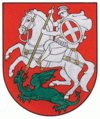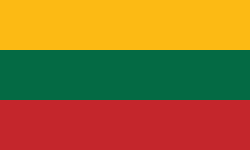Varniai
 |
It was established in the 14th century, on the bank of the Varnelė River, near an important Samogitian castle. It was the center of Samogitian Catholic church: after the baptism of Samogitia, the Samogitian Bishop resided in the town. Around 1414–1416 the first church was built, and c. 1464 the first cathedral.
Varniai was the center of Samogitian episcopate until the middle of the 19th century, when authorities of the Russian Empire moved it to Kaunas.
With support of Merkelis Giedraitis, Mikalojus Daukša translated and made ready for publication Katechizmas, the first Lithuanian language book printed in the Grand Duchy of Lithuania, then part of the Polish–Lithuanian Commonwealth.
It was also residence of Motiejus Valančius.
Map - Varniai
Map
Country - Lithuanian_Soviet_Socialist_Republic_(1918–1919)
 |
 |
| Flag of Lithuania | |
Germany had lost World War I and signed the Compiègne Armistice on 11 November 1918. Its military forces then started retreating from the former Ober Ost territories. Two days later, the government of the Soviet Russia renounced the Treaty of Brest-Litovsk, which had assured Lithuania's independence. Soviet forces then launched a westward offensive against Estonia, Latvia, Lithuania, Poland and Ukraine in an effort to spread the global proletarian revolution and replace national independence movements with Soviet republics. Their forces followed retreating German troops and reached Lithuania by the end of December 1918.
Currency / Language
| ISO | Currency | Symbol | Significant figures |
|---|---|---|---|
| EUR | Euro | € | 2 |
| ISO | Language |
|---|---|
| LT | Lithuanian language |
| PL | Polish language |
| RU | Russian language |















